Tamela Rich's Blog, page 2
December 1, 2017
The Process of Turning a Concept into a Book Cover
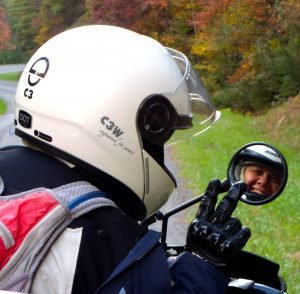 Inspiration for “Hit The Road” book cover
Inspiration for “Hit The Road” book coverFour Octobers ago, in the mountains of West Virginia, my friend Jill took this photo of me. It remains one of my favorite shots—as a photo, and as a memento of a gorgeous day with a dear friend.
When I wrote my new book, Hit The Road: A Woman’s Guide to Solo Motorcycle Touring, I knew I wanted to use that photo on the cover if possible. For a number of reasons it just didn’t work, and there was no good workaround that would make it look right by professional standards.
Collaborating with illustrator Rich Barrett
Andy Ciordia, my friend and designer said, “Tam, if only you had an illustrator who could take this picture as inspiration and make it work…”
I instantly replied, “I do! Rich Barrett.”
Watch this Facebook Live interview with Rich, where he takes you into his process of turning my photo concept into a super book cover.
It started with a clear creative brief from me and a conversation with Rich about the “spirit” I wanted the cover to convey. I told him I wanted a lighthearted feel because solo motorcycle touring fills me with such joy. Also, my research told me that many women are hesitant or downright afraid to hit the road solo.
I told Rich,”There are two problems with the photo (which was never taken with the intention of gracing a book cover):
First, the helmet dominates. I’d like the reflection in the mirror and the hand to be more dominant
Second, I’d like to see that little hint of a curvy road ahead be heading in the direction of my gaze.
I think simplicity is a virtue. This book cover will give you a sense of how simple the overall design can be.”
“Hit The Road: A Woman’s Guide to Solo Motorcycle Touring”
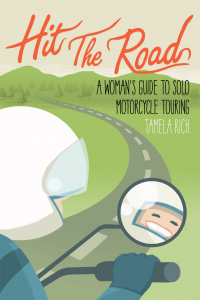
Available January 2, 2018, in print and digital editions, Hit The Road: A Woman’s Guide to Solo Motorcycle Touring includes stories from my motorcycle travels, plus checklists, tips, and resources for anyone who wants to get the best out of a two-wheeled adventure.
The book helps readers:
1. Identify their Traveler Type
2. Learn to plan the perfect itinerary for their Traveler Type
3. Understand their fears and how to overcome them
4. Choose personal safety devices and strategies best suited to them
5. Learn money-saving tips that will let them spend more time on the road
6. Prepare for travel by downloading checklists for packing, mechanical inspections, tools, and emergencies
7. Understand what to do if something unwelcomed happens on a trip
8. Experience the joy of traveling solo without feeling lonely
And much more…
The post The Process of Turning a Concept into a Book Cover appeared first on Tamela Rich.

October 16, 2017
My Grandmother could have used the Hashtag MeToo in 1934
Social media platforms are blowing up with the campaign #MeToo that protests the culture of silence around sexual assault. While the hashtag is used mostly by women, others are coming forward with their stories of abuse too.
If my beloved mamaw were alive today I’m not sure she would join the campaign, but she certainly had a story that fits the movement.
Mamaw wasn’t a woman of letters and was never one to “put herself forward” by writing a memoir. While I find her life and times fascinating, she likely considered them to be ordinary. Even the groping she experienced as an eight-year-old.
For several years my mom tried convincing Mamaw to write down some childhood memories, and maybe with the prescience that her time was drawing nigh, she finally obliged the request.
She wrote about several things, including the time her coal camp house was washed off its foundation in a thunderstorm. I’m using her memoirs to write a novel set in the first half of the twentieth century.
Uncle Anse the sexual predator
I’ve transcribed this scene it for you here as written, including her grammar and spelling, adding only paragraph breaks for your reading convenience.
When I was around 8 yrs old my Aunt Gertrude ask Mom if I could come to her house + watch Clara Faye. Her Brother in Law died + they were bathing + dressing him. So Mom sent me to watch Clara Faye.
I was bathing Clara so she’d be ready for the evening service. I had Clara on the table with a pan of water washing her. My back was to the door and those times we didn’t have screen doors so I didn’t hear Ance (married to Aunt Gertrude) come in.
He grabbed me + had his hands all over me + I jerked away + ran home. Don’t know what might happen if I hadn’t been quick.
I was afraid to tell Dad + Mom because I’d heard Daddy say if any one ever hurt one of his kids He’d kill them. I had a cousin that had gone to Prison for killing a man + I didn’t want Daddy going to Prison. I just stayed away from Ance.
When he died I wasn’t sorry he died.
Let’s break this down. Mamaw was eight. Anse’s wife had recently given birth to baby Clara—whom my eight-year-old grandmother was tenderly washing. The rest of the family was in another room washing a dead relative. Mamaw kept the secret so her father wouldn’t commit a crime and go to prison.
Although set in 1930’s Kentucky, Mamaw’s is a timeless story in principle. There is always a reason to keep quiet.
The post My Grandmother could have used the Hashtag MeToo in 1934 appeared first on Tamela Rich.

September 24, 2017
History, Music, Food, and Serenity at Kentucky’s Shaker Village
When you hear the word “Shaker” you likely think of 19th-century furniture. Fair enough.
That said, Shaker innovations went far beyond furniture and crafts. They invented:
The flat broom
The circular saw blade
The spring clothespin
Chair tilter buttons
The paper seed envelope.
They also developed social reforms that provided equal status for people of all ethnicities, and leadership roles for women that were equal to those held by men.
Shaker history and accomplishments are fascinating, and Shaker Village celebrates them. Located just half an hour from Lexington, Kentucky in Harrodsburg, it’s a fascinating and serene place to visit. I’ll be there again in 2018 with tour guests.
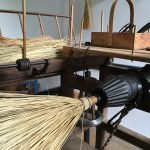
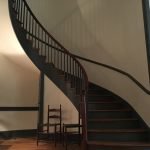

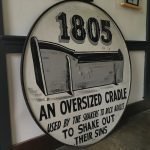
To view larger versions of these photos, simply click them.
Shakers were “Shaking Quakers” and celibate
The Shakers were a religious group that advocated pacifism, gender equality, communal ownership and celibacy. Yes, celibacy. They believed the second coming of Christ was imminent, and thus they needed to focus on purifying their souls instead of family life.
Still, the community survived and thrived without procreation, attracting more than 5,000 followers to communities in 10 states just before the Civil War. Shaker communities often became places of refuge for widows and orphans of the war. Children would be raised by the entire community and given the choice of staying or leaving once they reached maturity.
The Civil War placed the Kentucky Shakers uncomfortably between the opposing sides:
The Shakers believed in emancipation of the slaves, but as pacifists, they refused to bear arms. Their Federal neighbors could not understand the Shakers’ pacifist views. Secessionists were equally intolerant of the Shakers, who offered African-Americans full brotherhood in their community as early as 1811. ~Shaker Village website
The society in Kentucky was the third-largest in the country between 1805 and 1910. When it disbanded, the property was sold as any other, not intentionally preserved for history. Fortunately in 1961, a private nonprofit organization, Shaker Village of Pleasant Hill, was founded to restore the historic property.
When I visited in 2016 I knew I wanted to bring a group there to experience its serenity, and I’m doing that in 2018 with my “Mountains and Music Motorcycle Tour series.
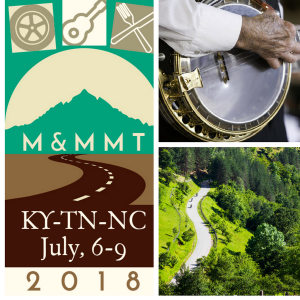 Learn more about the tour here
Learn more about the tour hereExperience the serenity of Shaker Village
Shaker Village has been spared the hustle-bustle of many historic properties. There are no historic re-enactors in costume. The staff explains that the Shakers would have been interesting neighbors in the present age, cleaving to their values while continuing their contributions to social, agricultural, mechanical—and no doubt digital—innovation.
During a 105-year span, the Kentucky Shakers constructed more than 260 structures on the property. Today, there are 34 surviving buildings, most located along the mile-long gravel turnpike, 13 of which have been turned into lodging. Named as a top hidden travel destination by BBC News, they are comfortably appointed with Shaker reproduction furniture, original hardwood floors and spectacular countryside views.
The serenity I experienced in 2016—out in the peaceful country under the stars—was exactly what my soul needed. I could have stayed for several days to decompress. If you watch the video at the top of this post you’ll get a sense for what I mean. You could explore its 3,000 acres, drink in the history, or snooze under a tree as your spirit moves you.
Shaker Village’s farm is a must-see
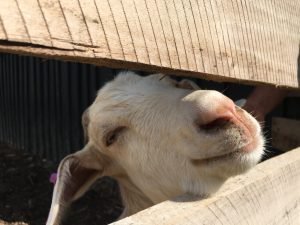 One of many friendly goats at Shaker Village
One of many friendly goats at Shaker VillageSince I’m a farm girl (and a 4-H’er) my favorite part of Shaker Village is the farm, where I learned about sustainable agricultural practices the Shakers used in the garden, orchard, livestock and apiary. Practices still in use today by artisanal and organic farmers.
I was fascinated to learn how co-locating a combination of specific breeds of animals effectively relieved the Shakers of certain farm chores, including composting and pest control. Who knew?
The farm provides fresh produce for The Trustees’ Table restaurant, and the meals are delicious.
Whether you visit with me on my tour or on your own, be sure to cruise on the Dixie Belle Riverboat through high limestone cliffs and untouched natural beauty on a one-hour narrated cruise. You’ll learn the historical importance of the river to the Shakers, and pass under High Bridge, an engineering marvel built in 1877.
Shaker Village supports a range of local musicians, featuring concerts on Friday and Saturday nights. Check out their YouTube channel here.
My tour guests will be treated to a private concert by Derek Spencer around a fire pit under the stars. Sigh.
The post History, Music, Food, and Serenity at Kentucky’s Shaker Village appeared first on Tamela Rich.

September 18, 2017
I’m Headed to Tuscany, Corsica, and Sardinia by Motorcycle in 2018
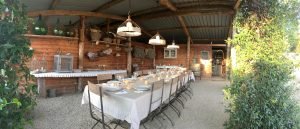 Our outdoor dining room, Podere la Strega
Our outdoor dining room, Podere la StregaIn 365 days I’ll be on my second Italian motorcycle tour.
From Rome, where we pick up our bikes, my group will head to the fabulous Podere la Strega in Siena. I catch myself thinking about Podere la Strega in unguarded moments and can’t wait to return. You know why if you’ve been there yourself!
The French Island of Corsica
From there I’ll head out into the Ligurian Sea on the western coast of Tuscany (with my Italian rental bike on a ferry—because they don’t make sea-crossing motorcycles yet!). Destination Corsica.
If you’ve ever heard of Corsica, it’s probably because that’s the birthplace of Napoleon Bonaparte. With the Italian mainland to the east and the Italian island of Sardinia to the south, Corsica is still French territory.
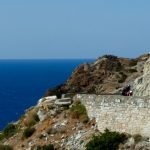 Between the mountains and the sea in Corsica
Between the mountains and the sea in CorsicaI hold no illusions that my high school French classes will do me much good, although I’m told that Corsicans, like Italians, have some English fluency. Then again, Google Translate helped me last time so I’ll be fine!
 Boar’s heads often adorn shops where the meat is sold
Boar’s heads often adorn shops where the meat is soldCorsica is gaining traction in the film industry, with three films shot there so far this year. Producer-director Robert Johnson says, “Corsicana has this beautiful downtown area that can pass for upstate New York, it can pass as Colorado mountains. Depends on how you art direct it…I mean, we have everything. We have lakes, we have fields, we have cattle.”
The food is a mix between Italian and French, of course. Corsicans specialize in wild boar (be still my beating heart) and seafood soup called bouillabaisse.
Check out the videos at the top and right of this post, or download the full itinerary and pricing here, including rental bike choices.
Italian Motorcycle Tour: Sardinia
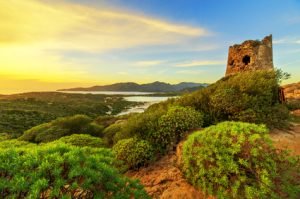 A panoramic view of Villasimius, Sardinia
A panoramic view of Villasimius, SardiniaAfter a ferry ride from the tip of Corsica to St. Teresa in Sardinia. To the island’s west is the Sea of Sardinia, and to the east is the Tyrrhenian, where I have been before.
We have a day off the bike in the resort town of Tresnuraghes. While there, I’m just as likely to tour the museums and archeological ruins as to nap on the pristine beach. That’s how I roll!
I’ll have four days to explore the island before a luxury ferry crossing back to the mainland. My Italian tour guide Enrico Grassi tells me (in the video below) how he likes watching for the “last drop of sun” from the deck of the ferry.
If you are a motorcyclist, I’d love for you to join me in Italy September 18-28, 2018. Download the full itinerary and pricing here, including rental bikes.
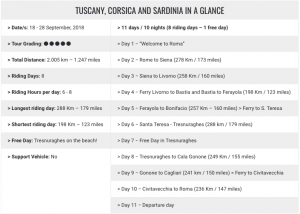 Click through for the full itinerary and pricing
Click through for the full itinerary and pricingThe post I’m Headed to Tuscany, Corsica, and Sardinia by Motorcycle in 2018 appeared first on Tamela Rich.

June 1, 2017
Henry Ford’s Kentucky Coal Camps: My Great-Aunt’s Memories
I recently spent a week in Kentucky with my Great Aunt Buntin in the video above. She is the youngest and only surviving sibling of six, all of whom born in the 1920’s and 30’s in a Kentucky coal camp near the West Virginia state line.
Coal camp life was tough, yet Buntin recalls some happy times and feisty memories of learning how to stand up for herself, and to make do with what she had.
When Buntin talks about “Versie” she is referring to my grandmother, whom I called “Mamaw,”and wrote about in this post. I hope you’ll watch the video—she talks about Mamaw shooting a tree rattler with a shotgun!
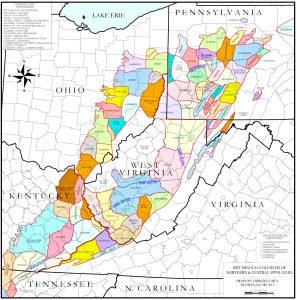 Appalachian Coal Fields Map
Appalachian Coal Fields MapWhat were coal camps?
When I said Mamaw and Aunt Buntin were born in a “coal camp,” I hope you note the temporary connotation of the word “camp” compared to “town” or “village,” or even “hamlet.” The explanation is straightforward. Coal companies set up cheap housing—bordering on temporary—since their operations were temporary; they sold out and moved on once the coal seams were thinned or exhausted.
Miners lived in the coal camps so they could walk to work. There were no roads into the mines in the early days, since coal itself was moved by rail. The camps eventually grew into villages and towns, but the name “coal camp” stuck, along with the temporary mindset.
Everything about the extraction economy was short-sighted, provisional, and unregulated. Timber, railroad, and mining operations destroyed the natural environment and as a result, rainstorms were often violent and deadly. Mamaw once told me that their coal-company-owned house slid off its foundation in a mid-night cloudburst and her family barely escaped from their beds with their lives.
Eventually the company decided to shore it up where it landed instead of securing it with a proper foundation.
Camping, indeed.
Even 100 years later, flooding is a problem in the region, as you’ll see in this video:
Thacker and Williamson coalfields
The maps here give you a sense of place, with a tip of the hat to the helpful website CoalCampUSA.com. Click the maps and they will pop up so you can see the detail.
The Thacker coalfield, where my family worked, was on the Kentucky side of the Tug Fork of the Big Sandy River. The Williamson coalfield was on the other side of the Tug, which defined the state line with West Virginia.
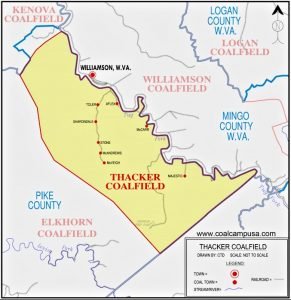 Map of some coal camps at the WV-KY border along the Tug River
Map of some coal camps at the WV-KY border along the Tug RiverTheir coal camp at Stone was—and still is—an unincorporated community in the Thacker Coalfield. Stone was established in 1912 and named for the founder of the Pond Creek Coal Company, Galen Stone.
Mining companies had an interest in keeping the communities of their camps unincorporated. The lack of governmental oversight meant they could run them with a plantation mentality, something many of them understood since the coal boom occurred on the heels of the Civil War.
Life in coal camps
Mining companies ran the post office, schools, kept the peace as they saw it, and even hired pastors for the churches. Most important, they required workers to shop at company stores, with inflated pricing that often kept the coal companies afloat during the “bust” part of boom-and-bust cycles, while keeping their workers in debt and on the job. How in the world did they do this?
Workers were not paid in real legal tender. The mining companies worked on a credit system using tokens called “scrip” that resembled coins stamped with the company’s name. Since company scrip was only accepted at face value at the company’s own stores, workers often ended their week owing more to their employers than they had earned—resulting in (debt servitude).
Legally, peonage was outlawed by Congress in 1867, but it wasn’t until 1938 that scrip became illegal under the Fair Labor Standards Act.
Henry Ford enters the Thacker coalfield
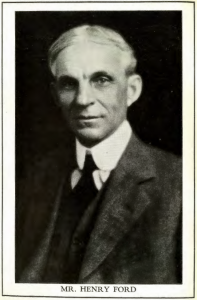 Henry Ford of Fordson Coal and Ford Motor Company
Henry Ford of Fordson Coal and Ford Motor CompanyOf course we all know that coal fueled Industrial Age furnaces, boilers and electrical plants. What you may not realize is that coal is a basic ingredient of steel. There are different grades of coal, and the kind that was mined in the Thacker coalfield can be refined into coke, which becomes steel when combined with iron.
Since Henry Ford made cars—which required steel, which required coke and iron—it was no wonder he wanted to go into the coke, iron, steel, and transportation businesses. When Ford Motor Company experienced a work stoppage due to a coal shortage in 1922 he made his move, forming the Fordson Coal Company to buy the Stone mines and others in the region.
The labor uprisings in the Appalachian coalfields led to price and supply fluctuations, which bedeviled Ford and other industrialists. Ford’s approach was to improve the quality of life in the camps by improving sanitation and adding amenities like a movie theater—where my grandparents had their first date (chaperoned, of course). Ford also improved working conditions and wages, of which he boasted in marketing materials:
“These alterations in the properties and living conditions as well as the increase in wages and the steadiness of occupation render outside interference, labor trouble, and the proverbial ills of coal mining communities relatively unknown.
“One is immediately aware that he has entered the property of the Ford interests when he steps across the line dividing the Ford mining camps and villages from adjoining properties. Incidentally, all of the foregoing influences on the life of the miner have their direct effect upon production. Happy, healthy miners dig more coal.” ~Ford Coal marketing brochure
Pictured here is a snapshot from a Ford Coal brochure touting the beauty and cleanliness of Stone. What’s not reported is that the rank and file miners like my great-grandfather and grandfather didn’t live in such luxury. The homes pictured in the brochures were only within reach of management.
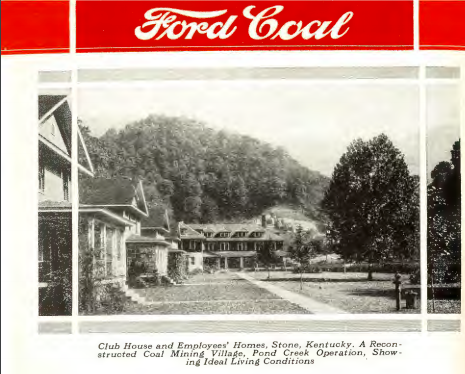 Ford Coal marketing brochure
Ford Coal marketing brochureMining wars: Henry Ford exits
Buntin’s father—my great-grandfather—helped unionize the Fordson mines. He was a brave man, since coal labor-management-government fights were the largest insurrection in American history outside the Civil War. When you understand the power that mining companies had over every aspect of their workers’ lives, right down to where they could shop and their rights to free speech in the coal camps, you might have a sense for the antagonistic environment of the day.
Ford sold the mine in 1936 Stone to Eastern Coal Company—determined to keep unions out of his organization by any means possible, including divestiture.
Matewan, West Virginia is home to the Mining Wars Museum. There, I learned a great deal about the turbulent labor-management-government clashes in West Virginia. I’ll tell you more about what I learned in Matewan in a future post.
PLEASE, if you know anything about this topic leave a comment. I’m hungry for more history!
I’ll tell you more Appalachian stories this year, since I’ve been on a “roots quest” of late. Stay tuned. Better yet, subscribe to my list and you won’t miss a thing.
Subscribe to this story series
The post Henry Ford’s Kentucky Coal Camps: My Great-Aunt’s Memories appeared first on Tamela Rich.

May 20, 2017
Four Mobile Apps for Finding Great Roadside Stops
Planning a great road trip might start considerations like a final destination on a specific arrival date, but why not add some roadside kitsch and history along the way? My philosophy is that the journey is an equally-important part of the vacation. #TravelSlow #ConnectDeep.
Mobile apps and push notifications
Mobile apps are a great way to find these stops. I’ve used the apps below to both plan my itineraries and for impromptu pullovers. “Push notifications” within the apps make the impromptus easy as they are geo coded.
I’ll always remember being in Stroudsburg, Pennsylvania on the way home from visiting President Franklin Roosevelt’s Hyde Park estate and presidential library. A notification came up on my phone from “Roadside Presidents” telling me that I was just 28 miles from the gravesite of FDR’s mistress, Lucy Mercer Rutherfurd. Holy cow, Big Brother!
Shopping for apps
While mobile apps can help you find everything from destinations and cheap gas, to camping and lodging, finding the right app can be a real time suck. That’s why I’m recommending four my favorites. If you want to search on your own consider these tips:
Stick to apps with a single focus. Mobile devices can’t handle complex menus and navigation gracefully
Look beyond the star ratings and read the reasons for each rating. Some reviews won’t apply to you and others will be nitpicks
Roadside America
This is my favorite mobile guide to the weird and wacky along the road. The app features 75+ Themes, searchable by state including:
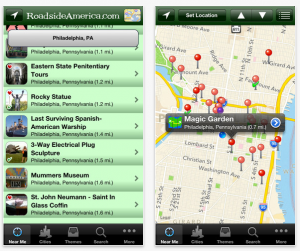 Roadside America app
Roadside America appFactory Tours
Haunted
Mythical
Nautical
UFO
“Sunset Alert” for shutterbugs
Price: $2.99-8.98 depending on content regions selected (and worth 10x more) for Apple devices only
Roadside Presidents
Uses the “weird and wacky” curation experts of Roadside America to find hundreds of destinations like:
[image error] Roadside Presidents app
JFK’s Bomb Shelter — FL
Lincoln’s Target Practice Board — IL
President Reagan Ate Here McDonald’s — AL
Statue of Andrew Jackson’s Mom — SC
$2.99 Apple devices only
Field Trip
Field Trip pulls information from publications like Thrillist, Cool Hunting, Arcadia, Run Riot, Sunset, Inhabitat, Daily Secret and more. The app also informs users of deals that are nearby, as well as interesting architecture, historic places, restaurants, art, and other unique locations.
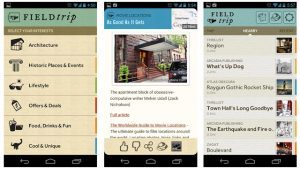 Field Trip app
Field Trip appOnce you install the app and log into your Google account, you can customize which sources you want to use, and the app runs in the background with automated alerts. I’m told the app works best on Android devices (duh, Google owns Android).
Discover:
Architecture
Historic Places & Events
Lifestyle
Offers & Deals
Food Drinks & Fun
Movie Locations
Outdoor Art
Obscure Places of Interest
Free for Apple and Android
History Here
Researched and written by the history experts at History (History Channel)
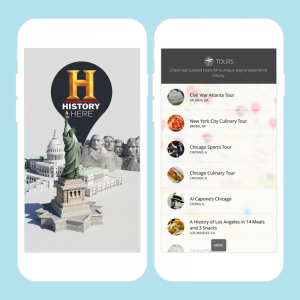 History Here app
History Here appGet the facts about the history that’s hidden all around you
Tours feature on themes like Al Capone’s Chicago, Nashville Music History, etc.
Free for Apple and Android
The post Four Mobile Apps for Finding Great Roadside Stops appeared first on Tamela Rich.

May 11, 2017
Lazio Italy by Motorcycle: Civita di Bagnoregio “the town that is dying”
Orvieto’s morning air delights my soul, encouraging me not to think about the tour’s end in the afternoon. Instead I remind myself to wring joy and memories out of its last day.
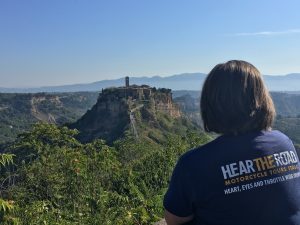 Tamela looking at Civita from the “mainland”
Tamela looking at Civita from the “mainland”The itinerary that our guide Enrico Grassi planned helps us all do just that, starting with Civita di Bagnoregio.
Etruscans at Civita
Founded by Etruscans more than 2,500 years ago, Civita is now known to Italians as il paese che muore (“the town that is dying”).
The good news is that the town is dying in a most tourist-friendly way. While fewer than a dozen people call Civita home, its three inns and private residences maintain high occupancy.
Civita is an inland island, surrounded by a valley of clay that eroding beneath the tufa (volcanic) stone. What isn’t eroding has been shaken away by earthquakes, the strongest of which was in 1794, destroying the natural bridge that linked Civita to the bigger nearby town of Bagnoregio.
 Approach to Civita—quite a trek!
Approach to Civita—quite a trek!
Today Civita can only be reached by a footbridge from the town of Bagnoregio, where Civita’s administration (and the bishop’s seat) relocated after earthquakes in 1695. The footbridge is quite a climb, and only Dan, Jo, Danette and I are inspired to take it. The views are spectacular.
The requisite piazza, church and gift shops greet us at the top and what interests Danette and me is the 3-D Etruscan exhibit in the tiny museum. We hold the red and blue 3D viewing lenses over our eyes to examine pottery shards, burial chambers and other archeological remains on large canvases. Several computer stations let us navigate inside Etruscan archeological sites in the region. Next time I visit Tuscany and Umbria, I’ll focus on the Etruscan sites, for sure.
Follow this Italy Series
Picnic in the park
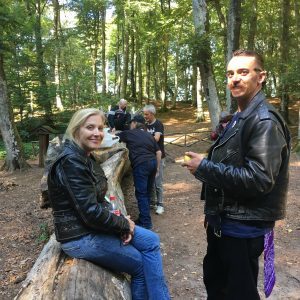 Denean and Derek at our picnic
Denean and Derek at our picnicBefore our final stop in Civita Castellana, we linger over a picnic lunch in Faggeta del Monte Cimino (“Beech Forest of Mount Cimino”). Enrico bought our provisions the day before in Orvieto at Norcineria Dai Fratelli.
He and the van driver Franco set up our buffet of wild boar salami, wild boar capicollo, prosciutto, formaggio gnorante (rude cheese) and of course pecorino, along with apples and rolls. Instead of a picnic table, we dine on a giant felled tree and we laugh and reminisce about our shared experiences on this exceptional tour.
Enrico is a master at understatement, telling us that a friend who lives there has “a little motorcycle museum we will enjoy on the way back to Rome.” This stop in isn’t on the tour, but as we have seen time and again, Enrico supplements the standard itinerary with things he knows will delight his guests.
Civita Castellana’s motorcycle collection
Pulling into the ancient city of Civita Castellana, home to some 16,000 residents, we stop at the Piazza Guglielmo Marconi and park our bikes. To our left is a gray, three-story building with a green garage door with the word, “GARAGE” painted in contrasting yellow capital letters. Inside is a motorcyclist’s equivalent of Ali Baba’s cave.
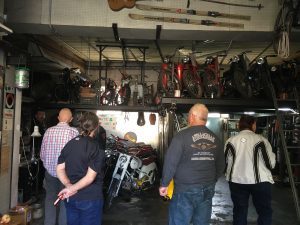 A motorcyclist’s equivalent of Ali Baba’s Cave!
A motorcyclist’s equivalent of Ali Baba’s Cave!Retired mathematics teacher Costante Costantini restores and displays a fine collection of Italian motorcycles and scooters inside. We all oooh and ahhh, but Derek is especially ecstatic.
Derek’s a motorcycle mechanic and Millennial MacGyver who did a field repair on Christin’s Guzzi exhaust pipe using a piece of cellophane cigarette box wrapper as loctite a couple of days ago. It doesn’t take him a minute to home in on Costante’s latest project: boosting an old Motobi engine by adding another one.
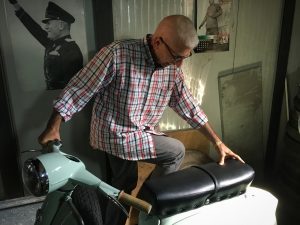 Costante and scooter (note Mussolini)
Costante and scooter (note Mussolini)The garage is chockablock with not only bikes, but also the bric-a-brac of Costante’s life. I laugh at an Mussolini poster and a 2007 wall calendar that also features the executed fascist dictator on the wall of a cubbyhole for scooters from the late 1950’s. Costante comes over to start one of them for me and I think to myself that the folks at Barber Motorsports Museum would love an introduction to him.
Back to Rome
That night at dinner, Jo surprises Enrico with our parting gift purchased in Orvieto: a butter dish, stocked with pats of butter, (burro). At first he is surprised, “Why do you want me to have a butter dish? I do not eat the butter.”
And then it dawns on him. We all share a belly laugh. (If you don’t know why we’re laughing you need to start at the beginning of this story series).
Arrivederci, Enrico and my fellow Americans. Each of you brought me moments of joy and laughter.
Grazie.

I’ll tell you more stories from Italy this year, since I’m returning to ride my motorcycle through Tuscany, Corsica, and Sardinia in 2017. Subscribe in the purple button below and you’ll never miss an installment of the story.
To start this series at the beginning, go here.
Follow this Italy Series
The post Lazio Italy by Motorcycle: Civita di Bagnoregio “the town that is dying” appeared first on Tamela Rich.

April 19, 2017
Appalachian Coal Heritage Tourism: Yes, This is Important
This week in my TV interview, I highlighted some “Coal Heritage Tourism Sites” in Virginia, West Virginia and Kentucky, where the mining industry provided not only income, also a way of life to its workers and extended communities.
Why is this important and interesting?
Why in the world would you want to tour coal mines and heritage museums?
The coal mining industry and mining communities have been front and center in today’s economic, scientific and political news. With projections that up to a third of American jobs could be replaced by robots and technology in the next 15 years, what’s happened to coal communities might be an interesting case study for all of us to think about and learn from.
On that note, I thoroughly enjoyed this post on the topic written by Travis Lowe, a pastor in Bluefield, West Virginia. He observes, “Many people have been crushed, many families destroyed in the wake of this storm but among the ashes, a few flowers have began (sic) to bloom.”
 Map of Coal Heritage Tourism sites in VA, WV, KY
Map of Coal Heritage Tourism sites in VA, WV, KYFive coal heritage sites to visit
I mentioned Virginia’s Coal Heritage Trail in my interview, where you can take self-guided tours. Wise County has a map of its own.
1. Pocahontas Exhibition Coal Mine in Tazewell, Virginia was the location of the start of this region’s coal boom. Since without a railroad, you can’t sell coal, its spur line launched the Norfolk and Western Railroad (now Norfolk Southern) into national prominence during the 1880s.
2. Beckley Exhibition Coal Mine in Beckley, West Virginia is worth half a day. I wrote about it extensively here. You can ride into the mine with a retired miner as your guide. The nearby exhibition coal camp includes houses, a company store and a schoolhouse where you’ll see what it was like to live in a coal camp. The staff there is helpful and friendly, many of whom lived in coal camps themselves.
3. Mining Wars Museum in Matewan West Virginia just opened 2016 and is state-of-the-art. Many of us have never heard about the “Matewan Massacre” or the Battle of Blair Mountain, so we don’t realize that coal labor clashes were the largest insurrection in American history outside the Civil War.
Matewan Massacre took place on May 19, 1920 and marked an important turning point in the battle for miners’ rights. It would take until the early 1930s for the government to recognized American labor unions that eventually led to the passage of the National Industrial Recovery Act (NIRA) of 1933.
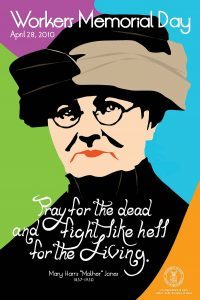 Department of Labor poster features Mother Jones and her famous quote
Department of Labor poster features Mother Jones and her famous quoteThe Battle of Blair Mountain ranged for five days in early September 1921, in Logan County, West Virginia. Roughly 10,000 armed coal miners confronted 3,000 lawmen and strikebreakers, called the “Logan Defenders,” who were backed by coal mine operators fighting attempts to unionize the southwestern West Virginia coalfields.
The battle ended after approximately one million rounds were fired, and the US Army intervened by presidential order. Private planes were hired to drop homemade bombs on the miners and dropped a leftover bombs from World War I in several locations near the towns of Jeffery, Sharples and Blair. Army bombers from Maryland performed aerial surveillance.
This PBS documentary goes into depth. You’ll learn the important role that Mother Jones, pictured right, played in the labor movement working the Appalachian coal camps, including Matewan.
4. The Stone Heritage Museum is just over the state line from Matewan, in Stone, Kentucky. This little heritage museum preserves the history and even payroll records of a coal camp that Henry Ford once owned in the company’s beautiful brick headquarters building. On a more somber note, one room of the museum is dedicated to the mortuary practice.
Stone played an important role in my life, because generations of my maternal family worked the mines there. Some extended family still lives in the area, but most have gone elsewhere.
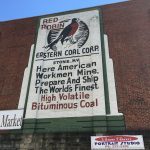
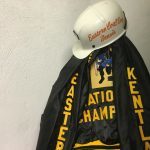
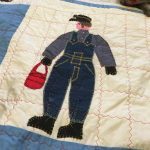
Next week I’m visiting my great-aunt in Kentucky. She’s the last of the generation who grew up in the coal camps at Stone. Together, we are piecing together family history as I research a book of historical fiction set in that era.
We plan to go to the Mining Wars Museum for a special event April 29th 6pm-8pm celebrating labor organizer Mother Jones’ birthday. Maybe I’ll see you there.
The post Appalachian Coal Heritage Tourism: Yes, This is Important appeared first on Tamela Rich.

April 8, 2017
Umbria by Motorcycle: Lake Corbara Towns
Everyone in Italy parks scooters and motorbikes chockablock. No matter how much chrome or how many farkles a bike is adorned with, I never saw an incident of I’m-too-special-and-my-bike’s-too-precious-to-share-a-parking-space behavior. If there is enough space to mount and dismount, that’s sufficient; share the space.
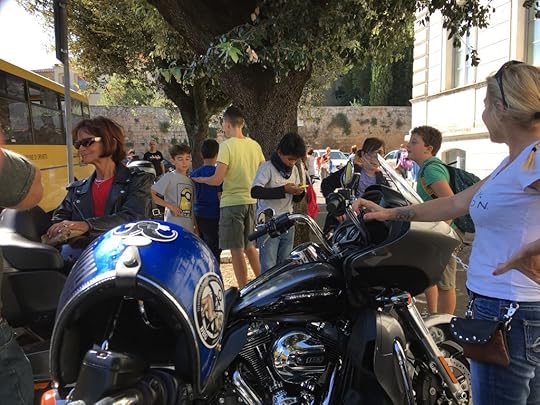 Orvieto school children
Orvieto school children
Our Orvieto parking lot is right beside a school, and as we prepare for our afternoon ride through Umbria, we are fortunate to witness school letting out for the afternoon. A fair number of pre-teens climb onto school buses while the others mill around in groups looking at their phones, flirting, and waiting for a parent to pick them up or walk them home. While we wait I ask our guide Enrico about the public school system in Italy.
Italy’s education system
Until middle school, the core educational curriculum is the same for all pupils, no matter whether they go to a private or state-funded school. Kids in state schools tend to outperform those in private. In 2013, Italy’s secondary education was ranked as the 21st in the world, above the United States and the OECD average.
By the time students reach what Americans call high school, Italian students follow in one of three paths:
Liceo (lyceum), which equates to what we call “the liberal arts”
Istituto tecnico (technical institute), which prepares students for careers in everything from humanities, administration, and law, to technology and tourism
Istituto professionale (professional institute), which teaches practical subjects like engineering, agriculture, gastronomy, technical assistance, and handicrafts. This program enables students to start a job as soon as they finish, which could be between 3-5 years.
Students who attend any of these programs for five years and earn a diploma are eligible to sit for a university entrance exam.
Enrico tells me that he specialized in agriculture at instituto professionale and then everything about his knowledge and passion for food and culture locks into place for me. No wonder he knows the type of soil where broccoletti thrives, and the herbs that goats eat which in turn gives pecorino cheese its distinctive taste.
If you’ll give me a moment to opine, there are merits to the Italian system over the American, not only in student performance. I also see benefits to a society whose youth are equipped to start real careers without crushing student debt acquired in excessive years of university over that which is truly required to do a job. As the mother of two millennials I know of what I speak. Americans indiscriminately preach “university, university, university” to kids from elementary school on up, despite underemployment for recent college grads. I’ll step off my soapbox now.
Follow this Italy Series
La Strada delle Mille Curve (“road of a thousand curves”)
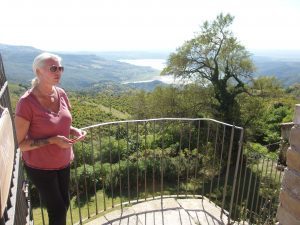 Christin overlooking Lake Corbara
Christin overlooking Lake CorbaraAfter the buses pull away from our little parking lot we mount up. Leaving Orvieto, we ride what Italian motorcyclists call La Strada delle Mille Curve (“road of a thousand curves”) toward Todi. The Italian claim of a thousand curves here is no more hyperbolical than boasting 318 curves in 11 miles—looking at you, Tail of the Dragon—but I enjoyed La Strada delle Mille Curve much more.
We are now touring the scenic roads that circle Lake Corbara. Created by a 701-yard-long dam erected across the river Tiber in the 1960s, the lake and surrounding lands are used as a recreation area, and the water itself irrigates the region.
After a couple of miles on a hard pack gravel road, we get to see Lake Corbara in its glory from high above in Titignano, another agriturismo.
Titignano
Striding in from the parking lot to the piazza, we can tell that a celebration of some kind has recently taken place because there are still decorations amongst the strings of lights overhead. Other than our little party, not another soul makes their presence known.
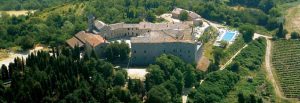 Titignano agriturismo
Titignano agriturismoTitingnano’s castle was built by a family with French origins in 937 AD. In 1830 a Florence prince bought it at an auction from a Pontifical State that had confiscated it as part of the century-long medieval conflict between what we would today think of as political parties: the Guelphs, and the Ghibellines.
Orvieto was a Guelph enclave since the city was largely mercantile families, loyal to the pope over the emperor. Nearby Todi is next on our agenda and in contrast to Orvieto, comprised of wealthy landholders. This is why Todi was Ghibelline, and feared enlargement of the Papal States.
The strong afternoon light glints off the lake’s surface and makes me want to lie down for an afternoon siesta, and it appears that others feel the same. Or maybe it was the delicious meal in Orvieto. Okay, maybe it’s not the sun or the meal. We’ve been going at it pretty hard for the last week.
Todi
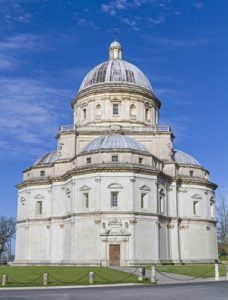 Santa Maria Della Consolazione in Todi
Santa Maria Della Consolazione in TodiOn the outskirts of Todi sits Santa Maria Della Consolazione, a refreshingly simply Renaissance church that I fell in love with after the Gothic overload of Siena and Orvieto architecture.
Overlooking the east bank of the Tiber, Todi was held up as the model of a sustainable city by Richard S. Levine, a professor of architecture at the University of Kentucky. Enrico tells us that Americans are beginning to move there for their retirement.
In the piazza that bears his name stands a statue of Giuseppe Garibaldi, whom I’m embarrassed to admit that I didn’t know until that afternoon. I ask Enrico about him and he tells me that Garibaldi was a central figure in the 19th Century movement for Italian unification.
Enrico is obviously proud of Garibaldi, whose successful military campaigns in both Latin America and Europe made him the “hero of two worlds.” Roberto Rossellini directed a film about him in 1961 and claimed it was the one of which he was most proud. It’s on my watchlist.
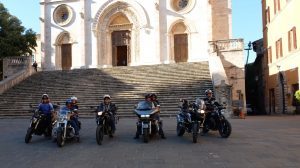
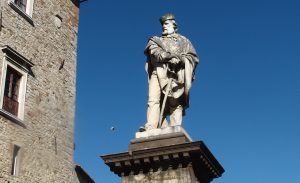
Fascinating factoid: Garibaldi was instrumental in President Lincoln’s Emancipation Proclamation; details in the video below.
Exiting Todi requires a ride down a narrow via with a near-vertical drop. Stairs had to be cut into the pavement for pedestrians. Enrico wisely leads us on our way instead of cautioning us in advance. After all the road presented us with no real danger and after a day of riding our tires are hot enough to stick. Later, we will laugh nervously trying to imagine that little via on a snowy or rainy day. Whew.
Follow this Italy Series
When we arrive at Altarocca, we spend a couple of hours as a group laughing and talking in the warm waters of its spa. We have truly come to enjoy each other’s’ company and begin talking about rallies in coming year where we might rendezvous.
In the morning, we’re for Rome.
I’ll tell you more stories from Italy this year, since I’m returning to ride my motorcycle through Tuscany, Corsica, and Sardinia in 2017. Subscribe using the purple button above and you’ll never miss an installment of the story.
Here is the beginning of the series. The next installment is a surprise stop in Civita Castellana to ooh and ahh over a vintage motorcycle collection.
The post Umbria by Motorcycle: Lake Corbara Towns appeared first on Tamela Rich.

April 1, 2017
Umbria Italy by Motorcycle: Orvieto’s Etruscans
The Umbria town of Orvieto sits atop a plateau of tufa rock—consolidated volcanic ash that we would call “tuff” in English. The rock was thrown from the large crater that is now Lake Bolsena, which we visited four days ago.
Our home base for the next two days is Altarocca Wine Resort. Its buildings are made of this tufa rock, as is most everything else in the area.
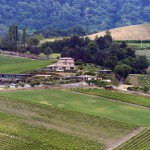

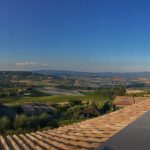
While our Siena agriturismo Podere la Strega was drenched in Old-World charm, Altarocca is all about modern decadence. It boasts an outdoor swimming pool and Jacuzzi, a spa with whirlpool, Turkish bath, and sauna… nestled into the center of a winery with four-star food.
And oh, the food…
Altarocca tasting menu
Dinner is the resort’s tasting menu: pork liver on mashed potato (the waiters called it “smashing” potato), stuffed zucchini flower, onion soup, Tagliatelle with duck ragu, lamb ribs with pepper and chicory, and a dark chocolate terrine with apricot sauce.
Although we’ve been in Italy for nearly a week now, our stomachs are still not on Italian time. An 8:00 meal feels like midnight to me and no doubt like the middle of the night to Los Angeles resident Christin, a human resources executive there.
Follow this Italy Series
The bread-with-butter-before-dinner controversy
If you’ve been following this series closely you know that eating bread before the main course arrives is a running joke between the Americans and our Roman born-and-bred guide Enrico. Italians simply don’t do it, but of course Americans do.
The wait staff makes the “mistake” of bringing bread to the table before our meal. Dan is married to an Italian-American and therefore “knows better,” but his stomach prevails as he bravely makes his move on the bread basket. As Enrico begins chiding him—and lucky for us his attention is diverted to Dan—we all stealthily grab a slice.
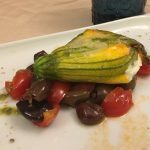

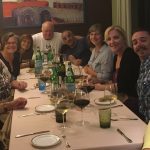
Butter on bread is another point of American transgression against Italian foodways. Denean from Louisiana quietly asks the waiter for butter, which we haven’t had in five days. When it arrives, we all ask her to pass it along. Like an indulgent grandfather, Enrico pretends not to notice our “English” behavior—that’s how he thinks of butter on bread, as an English peccadillo.
When he and the other smokers go outside for a lungfull, the rest of us brainstorm ideas for a thank-you present for Enrico, whom we have come to love despite—or perhaps because of—his staunch upholding of the Italian gastronomic tradition.
We decide it must have something to do with bread. A fancy bread basket? A butter dish? It must be something uniquely memorable of our experience. We agree to keep our eyes open the next day in Orvieto.
Orvieto
The locals call Orvieto La Rupe—“The Rock,” and it is seated above the vineyard-striped valleys surrounding it.
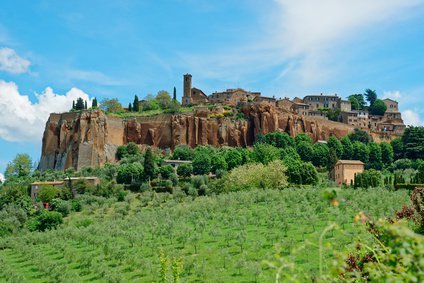 The town of Orvieto in the Umbria region of Italy sits atop volcanic tufa rock
The town of Orvieto in the Umbria region of Italy sits atop volcanic tufa rock
We approach La Rupe in morning traffic, making an unbelievably-sharp right hairpin turn from a dead stop on a hill. Enrico warns us with a hand signal and his own example how to approach it. I am second behind him and as I look to my left, sun in my eyes, I come to a halt in traffic to allow right-of-way to traffic to pass. I can’t make both the climb and hairpin without backing down five or six feet for runway, and because we’ve all been riding together for several days everyone behind me edges back accordingly.
Nice teamwork, eh? When we pull into the parking lot my friends are very gracious about my travail.
Archeology tour of Sant’ Andrea
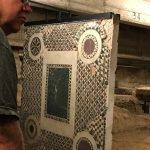
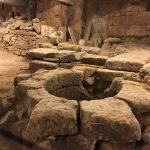
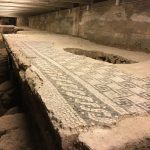
Enrico’s original plan for our Orvieto visit did not include a tour of Sant’ Andrea (Saint Andrew’s), but when a friend told me of Etruscan ruins underground and the possibility of a guided tour, I asked Enrico if we could add it to our itinerary.
Everyone else agreed and he arranged it with the archeologist, giving us a fascinating glimpse of not only the Etruscan forum and their building technologies, also the 6th century basilica. See the video of our archeologist at the top of this post.
Follow this Italy Series
The ruins confirm that Etruscans inhabited Orvieto from roughly 900 BCE until the 3rd Century BCE. To mark time for my fellow Americans, this means the Etruscan society started at about the same time as the Early Woodland period in North America (Central Europe’s Iron Age). It continued until the time the Roman Republic fought its epic battles with Carthage (264 BC to 146 BC).
My tour of Sant’ Andrea further fuels my interest in this ancient people. Next time I visit I’ll tour the Etruscan museo, “Claudio Faina” near the Cattedrale di Santa Maria Assunta.
Food shopping in Orvieto
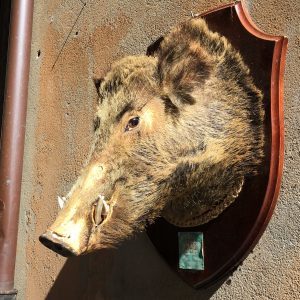 Boar’s head at Norcineria Dai Fratelli
Boar’s head at Norcineria Dai FratelliAfter our fascinating archeology tour, we spend the morning strolling Orvieto, surreptitiously scanning the shops for Enrico’s gift.
After lunch several of us are with him when he gets the bright idea to buy meats and cheeses for a picnic on our way home to Rome tomorrow. He knows just the place, Norcineria Dai Fratelli. Visitors can identify it by looking for the mounted boar head to the right of the entryway.
Next door is a pottery shop that has a basket of wares outside, including a small butter dish that Jo and I think is the perfect memento for Enrico. We plan to give it to him at our farewell dinner.
I cover for her absence with the group as we follow Enrico into Norcineria Dai Fratelli. Inside is a now-familiar sight—wild boar sausage hams hang from the ceiling, a nub of femur bone staring at you, and fur intact. Enrico selects sausage and cheese with the enthusiasm and expertise of a proverbial kid in a candy shop.
Every time I step into a butcher shop in Italy I’m reminded of where “real food” comes from, in contrast to the styrofoam and plastic trays that disguise food origins back home.
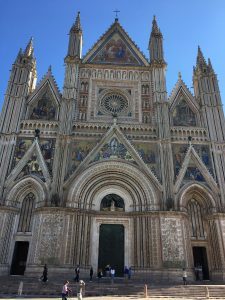 Orvieto’s duomo, Cattedrale di Santa Maria Assunta
Orvieto’s duomo, Cattedrale di Santa Maria AssuntaDo you know that some schoolchildren can’t identify basic foods like tomatoes, mushrooms, potatoes and cauliflower? For more on this point, watch Jamie Oliver’s TED talk and prepare to be amazed.
I’ll tell you more stories from Italy this year, since I’m returning to ride my motorcycle through Tuscany, Corsica, and Sardinia in 2017. Subscribe using the purple button above and you’ll never miss an installment of the story.
Here is the beginning of the series. The next installment is from Umbria’s Lake Corbara towns.
The post Umbria Italy by Motorcycle: Orvieto’s Etruscans appeared first on Tamela Rich.




